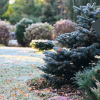20 May 2024
World Water Series – Fog Harvesting in Chile
Water is essential for survival, yet in many regions worldwide, it’s not readily available. As a result, people have had to get inventive and find other ways to access this precious resource. One such example is fog harvesting.
In this edition of the World Water Series, we explore how Chileans are ingeniously utilising the abundant fog from the Pacific Ocean, transforming lives in the process. But first, let us paint a picture of the region.

In the northern part of Chile, over 103,000 sq kilometres comprise desert landscapes. Did you know there is a place on the earth where no rain has ever been recorded? That place is Calama, nestled in the Atacama Desert. While rainfall is scarce in the surrounding areas, the marine fog plays a vital role in sustaining what little vegetation exists.
Despite the deserts arid conditions, there is a remarkable phenomenon that occurs every 4 or 5 years: seeds lying dormant for centuries suddenly sprout with rainfall. It is an incredible example of the resilience of plant life in harsh environments. While in the southern part of the region they experience rain and snow.
Enter fog harvesting - an ingenious invention that captures fog, turning it into usable water. Sunlight desalinates the droplets, making the water suitable for consumption after filtration.
So how does it work?
A mesh-like canvas is vertically attached to poles, akin to setting up a tall volleyball net. This mesh traps air particles, with a gutter or trough attached beneath to capture the fog droplets. Pipework leads these droplets to water storage tanks at the base. Annually, ten billion cubic metres are available in the Chilean clouds, with just 4% sufficient for a year’s requirements. With a catchment area of 40m3, a fog harvesting system can collect up to 66 litres of water daily.
As technology advances, alternating the mesh fibre size and coating increases water collection efficiency. Mimicking nature, narrower leaves are more effective at capturing smaller droplets. Similarly, mesh designs should consider these observations.
Benefits for the Region
Despite the aridity in the Chanaral Province, former fishermen transitioned to Agriculture, cultivating Aloe Vera due to its hardiness and the now availability of water. They not only get an income, but they also consume the Aloe for health benefits. Significant amounts of harvested water irrigate vegetation, reforest native species, and provide for animals.
Tourism has had a boost with visitors coming to witness fog harvesting systems in action or to sample locally brewed beer made from harvested fog.
Residents are adapting their daily routines, from livelihoods to easier water collection methods.
In conclusion, fog harvesting offers a simple, low-cost solution adopted by many worldwide.
While it might not be applicable everywhere, exploring similar projects – even on a small scale-can be rewarding. Numerous online resources can guide you through these endeavours whether it’s simply a weekend project with your children or something more extensive.


